Single Burial Avalanche Rescue
Single Burial Avalanche Rescue
Obviously, the best way to avoid a rescue is to avoid the avalanche all together. Take an Avalanche Course to be proactive and learn how to avoid avalanches. That said, even the most trained professionals can still make mistakes, so everyone traveling in the backcountry should understand how to execute a rescue. At the least, you could help save someone else’s life. Below are the steps to follow if ever you need to perform an avalanche rescue of a single victim.
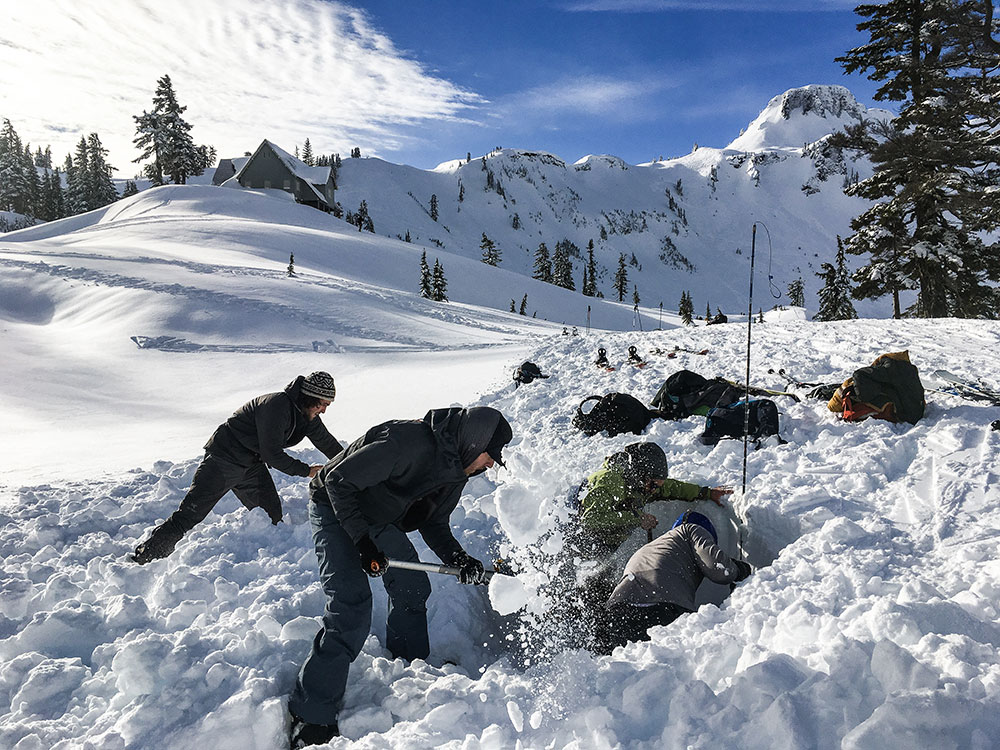
Avalanche Rescue Checklist
Step 1. (You’re number one). STOP! ASSESS SAFETY! ENSURE NO FURTHER HAZARD
-Risk of second avalanche?
-Hangfire?
-Move to defined safe location
Step 2. CHOOSE A LEADER
-Delegate Tasks
Step 3. HEAD COUNT
-How many missing?
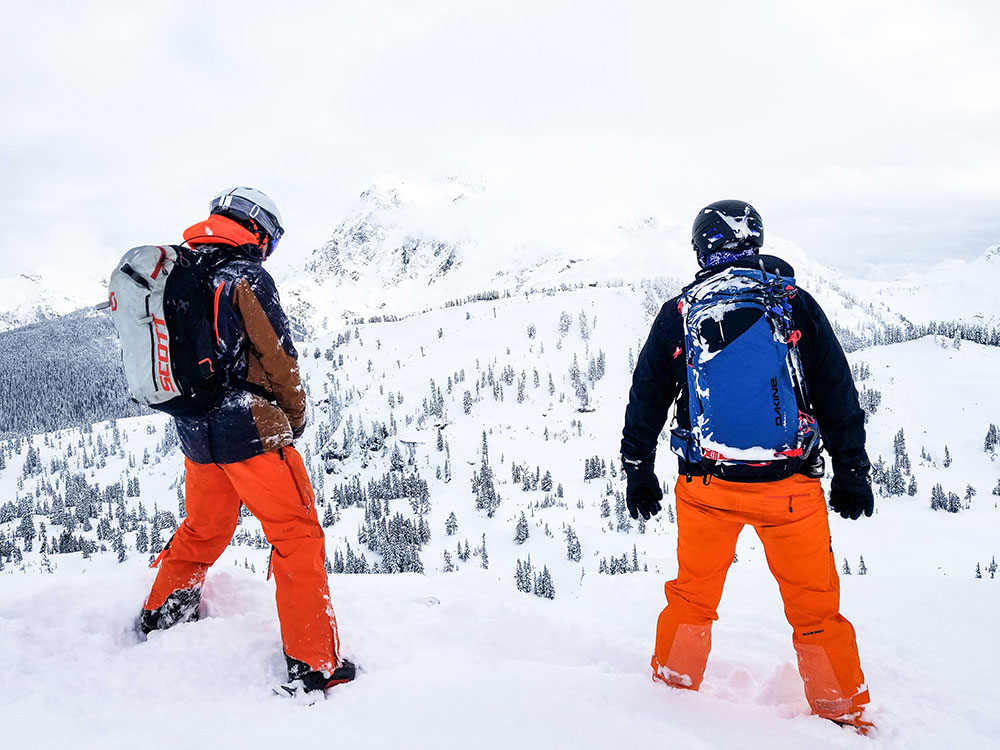
Step 4. CALL FOR HELP
-Others nearby who can help?
-(911) Location, nature of emergency, name, # in group, # missing
Step 5. SWITCH ALL TRANCEIVERS TO SEARCH MODE
-Check that no tranceivers are transmitting
Step 6. DETERMINE WHERE TO SEARCH
-Below point last seen
-In line with visual clues
-Areas of debris, especially terrain traps
Step 7. SEARCH FOR VISUAL CLUES
-Enter debris from side or toe of path
-Search strips 40m apart (About 40 strides)
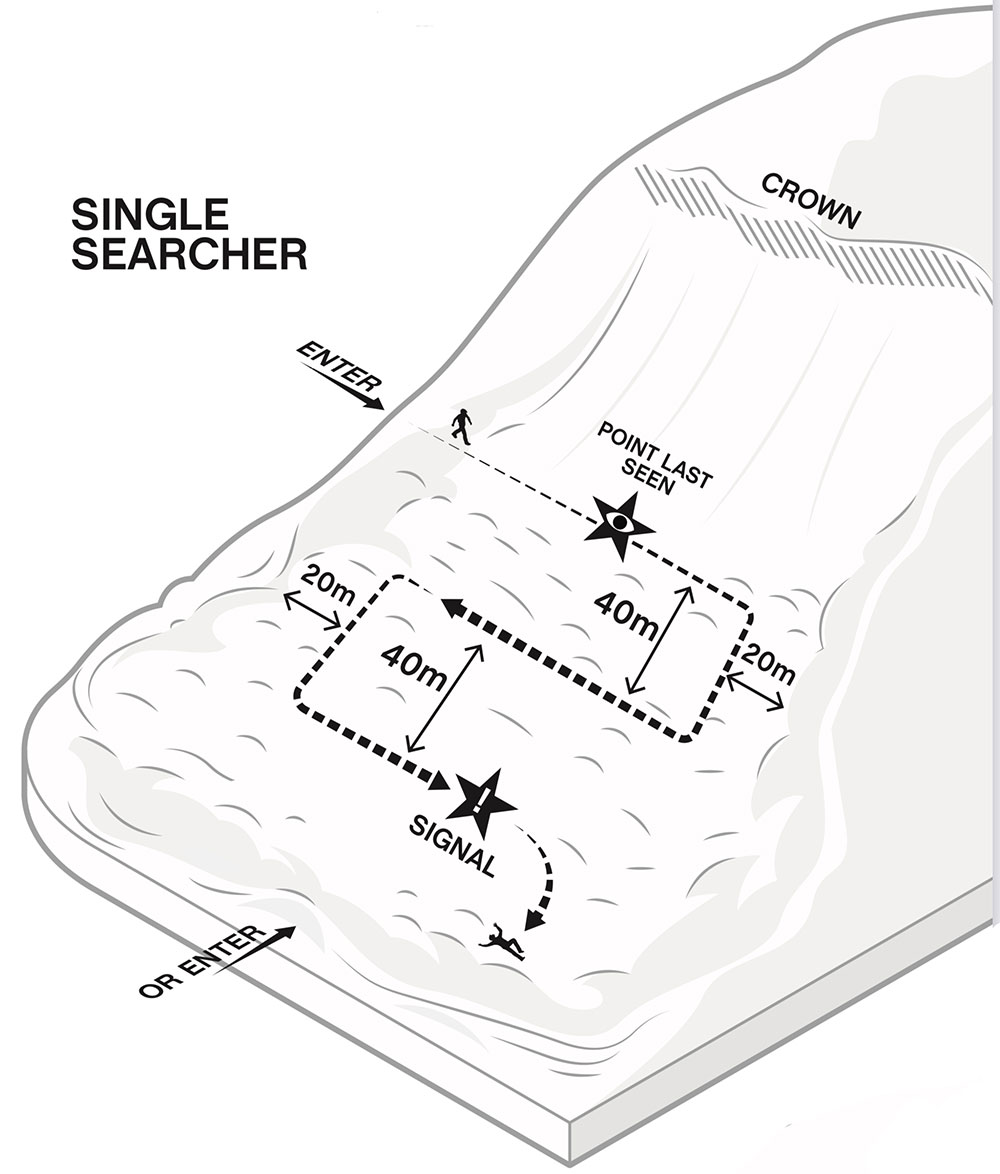
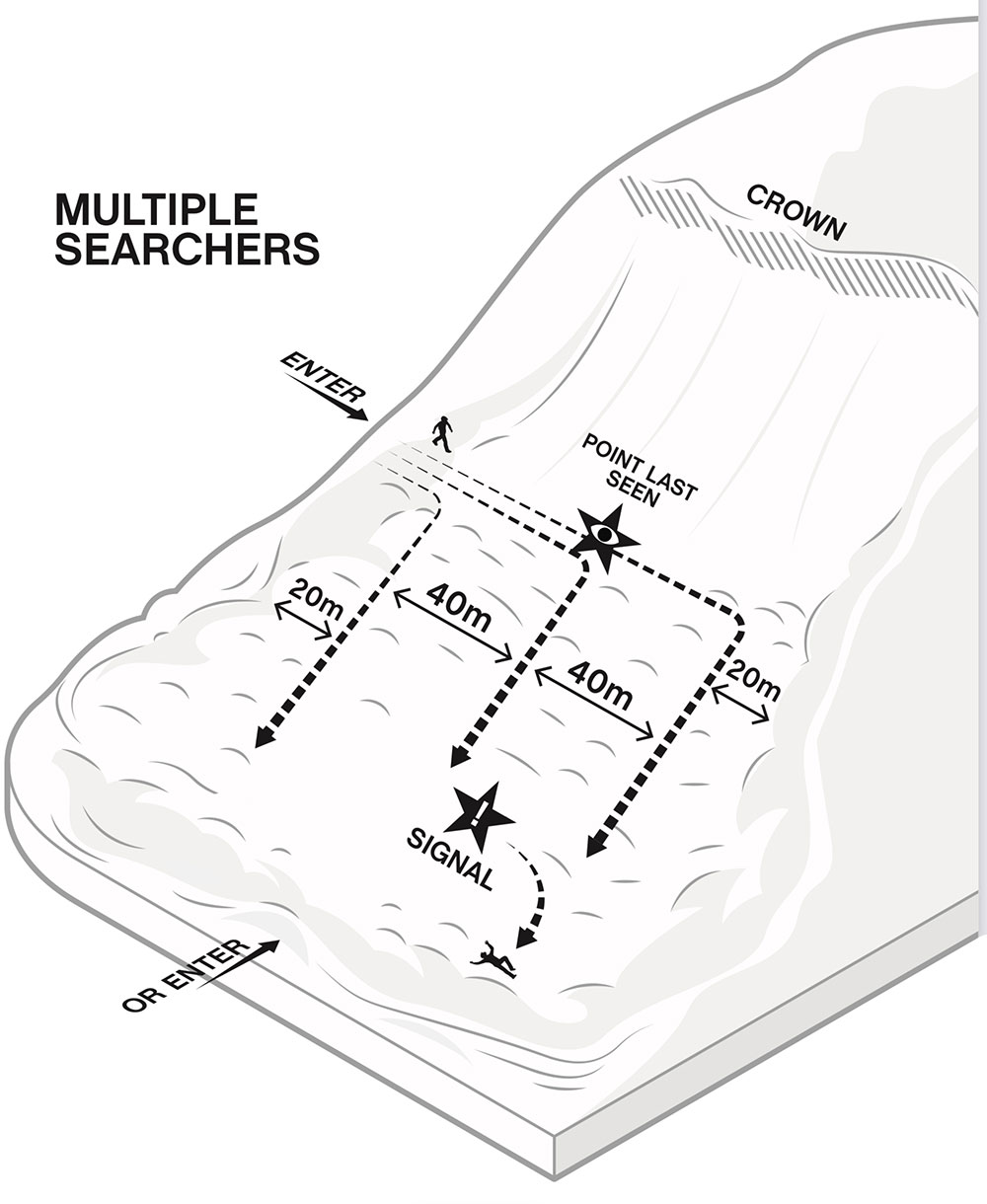
Step 8. YELL TO OTHERS WHEN YOU FIND A CLUE OR RECEIVE A SIGNAL
-Pull clue out of snow and lwave on snow surface
-Put marker in the snow where you begin to follow signal
-Call to other searchers not following signal to assemble probe and shovel
Step 9. FOLLOW SIGNAL TO BURIAL AREA
-Slow and precise as you approach 10m
-Keep tranceivers near the snow surface during final approach (Crawling at 3m)
-Around 5m, place a marker on the snow that points along the approach trajectory
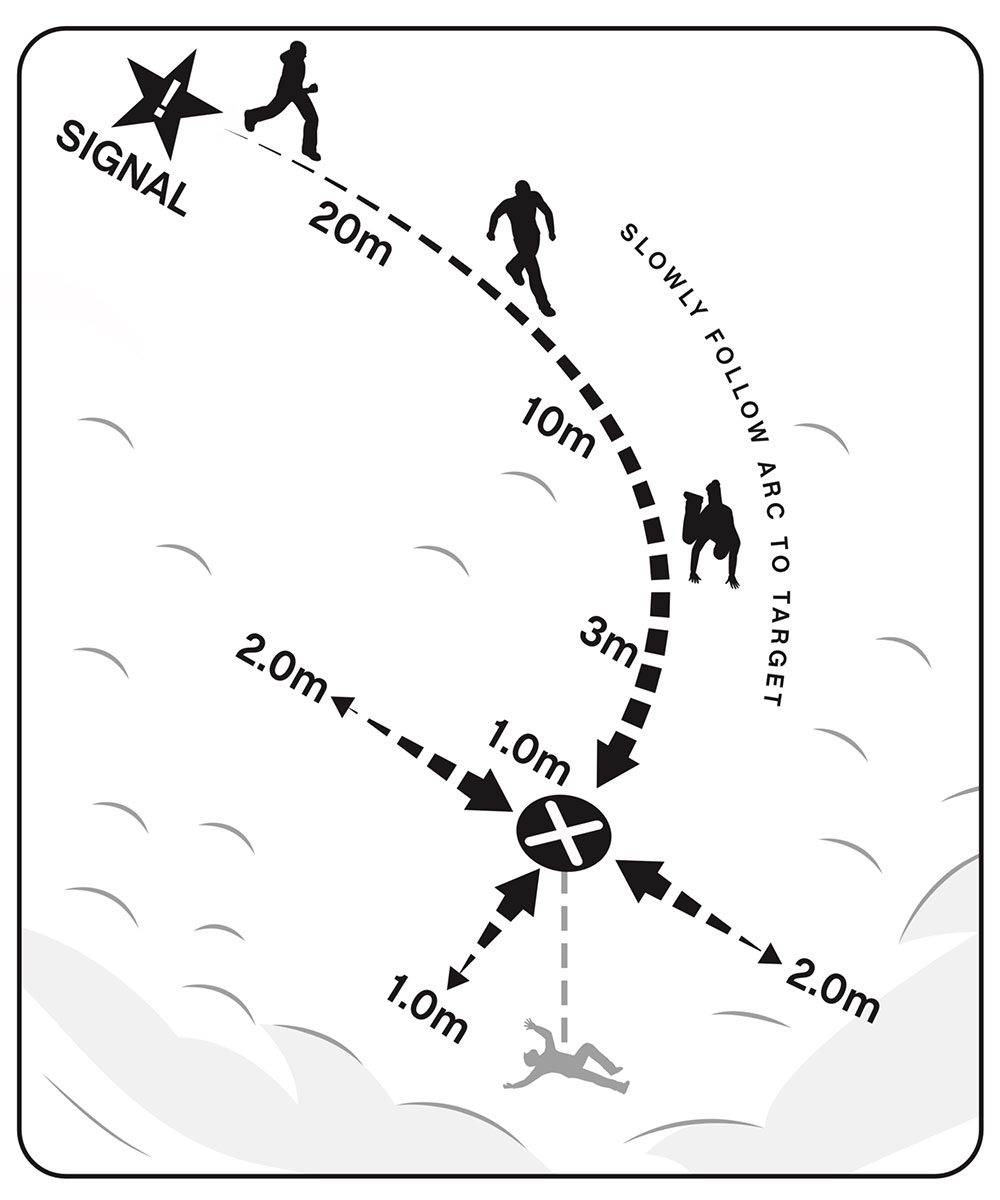
Step 10. LOCATE BURIAL WITH TRANCEIVER AND PROBE
-If possible, 2nd searcher PROBES LIKELY BURIAL AREA in front of tranciever searcher’s trajectory until closest signal located
-Locate the closest transceiver signal by bracketing ahead/behind and to the sides, maintaining consistent transceiver orientation
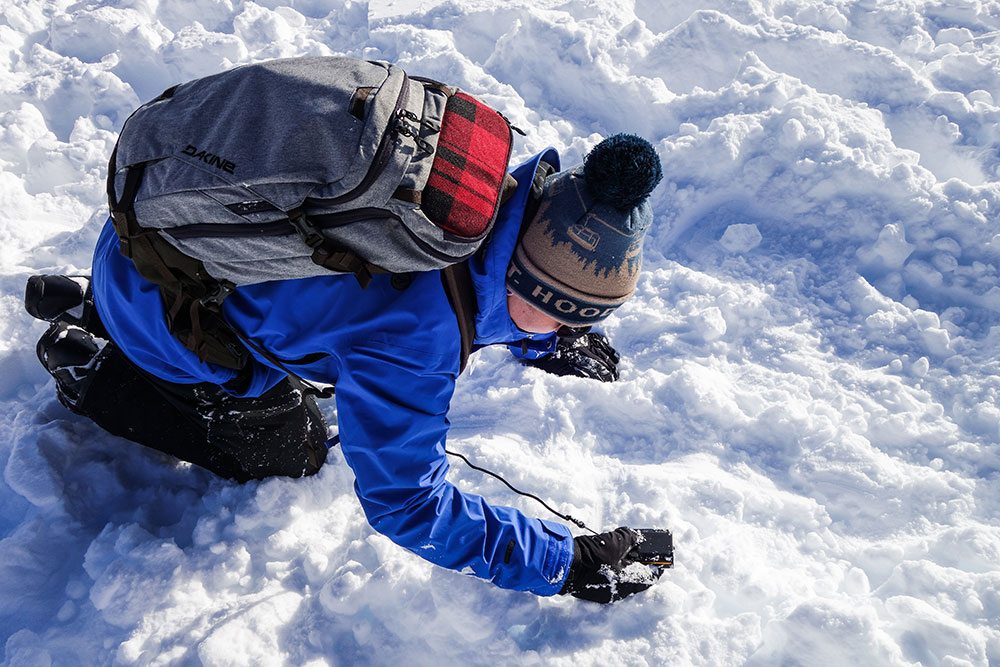
-Pinpoint using the probe, from the center of the closest signal outwards in a circular pattern
-Probe strike = victim location. LEAVE PROBE IN PLACE!
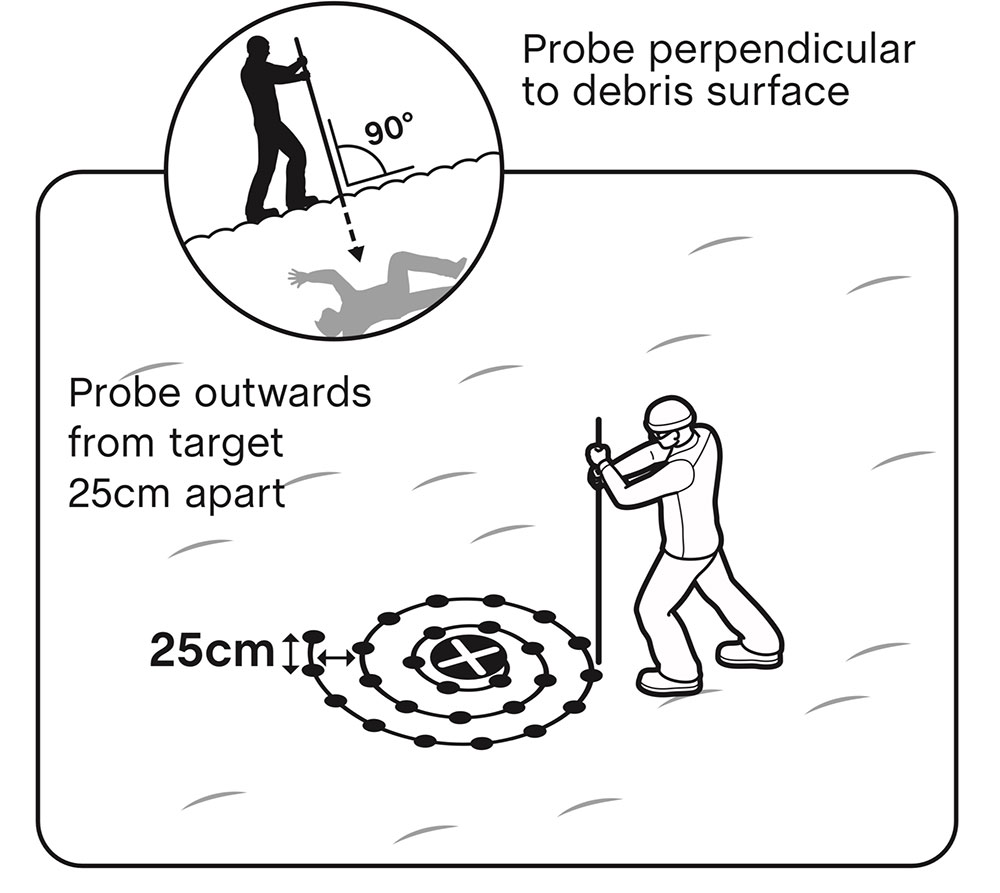
Step 11. SHOVEL FAST AND EFFECTIVELY
-Start with a large step downhill and away from the probe, 2 or more steps if deep burial
-Dig towards the probe; throw snow far away
-CHANGE SHOVELERS OFTEN (if other available)
-Careful shoveling as you reach your buried companion
-Expose face immediately in order to get airway
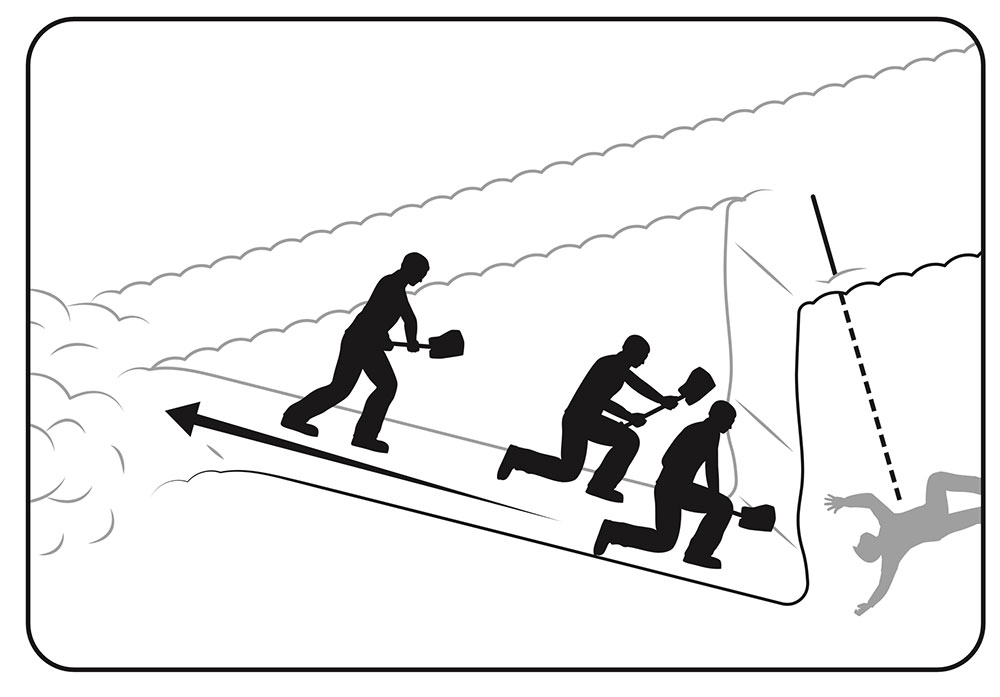
Learn more about Strategic Shoveling Techniques.
Step 12. PATIENT CARE
-Clear airway
-Provide First Aid or CPR as required
-Move to safe terrain
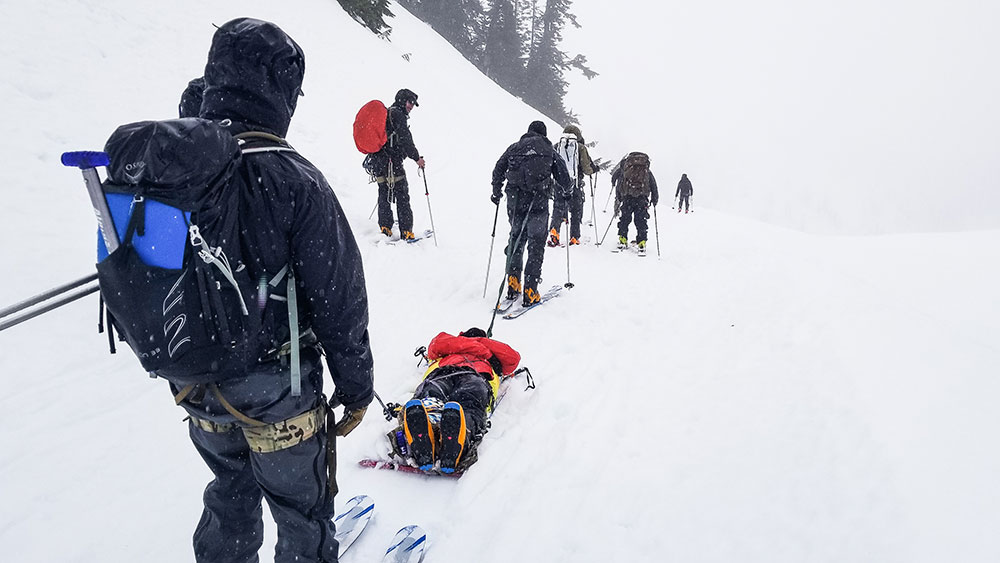
-Plan evacuation and follow up on call for help
Consider taking a Wilderness First Aid or Wilderness First Responder Course.
IF HELICOPTER COMES TO YOUR AID
-Secure loose items so they do not blow away
-When heli lands, wait for rescuer to come to you
Summary
It takes a lot of practice to get good at rescue and, even once mastered, is a perishable skill. Stay fresh on the most up to date practices and advances in the industry by taking an Avalanche Rescue Course at least every other year. Below is a great video put out by BCA that summarizes beacon searching well. Skip to 2:34 to get the most useful info.
Want to learn more? Check out our Ultimate Guide to Backcountry Skiing.
Strategic Shoveling
for Avalanche Rescue
Strategic Shoveling for Avalanche Rescue
The average burial depth in an avalanche is around 1.3 meters, which equates to about 1-1.5 tons of snow to move in order to extricate someone from avalanche debris. That’s just on average, in reality, someone could be buried much deeper. How long can someone survive under the snow? On average, if you get someone out in the first 15 minutes, they have a 92% chance of survival as long as they are not dealing with any major trauma. After that… the numbers are bleak. Survival rates drop to 37% after 35 minutes.
Over the years, From 1977-2000, the mean rescue time for recreationists (this includes beacon search) was 29 minutes. From 2000-2006, with the increase in avalanche education and more refined strategic shoveling techniques, the mean rescue time for recreationists decreased to 18 minutes. Research shows that the best way to decrease rescue times and overall mortality rates is to decrease the time spent in the shoveling phase, so let’s get into it.
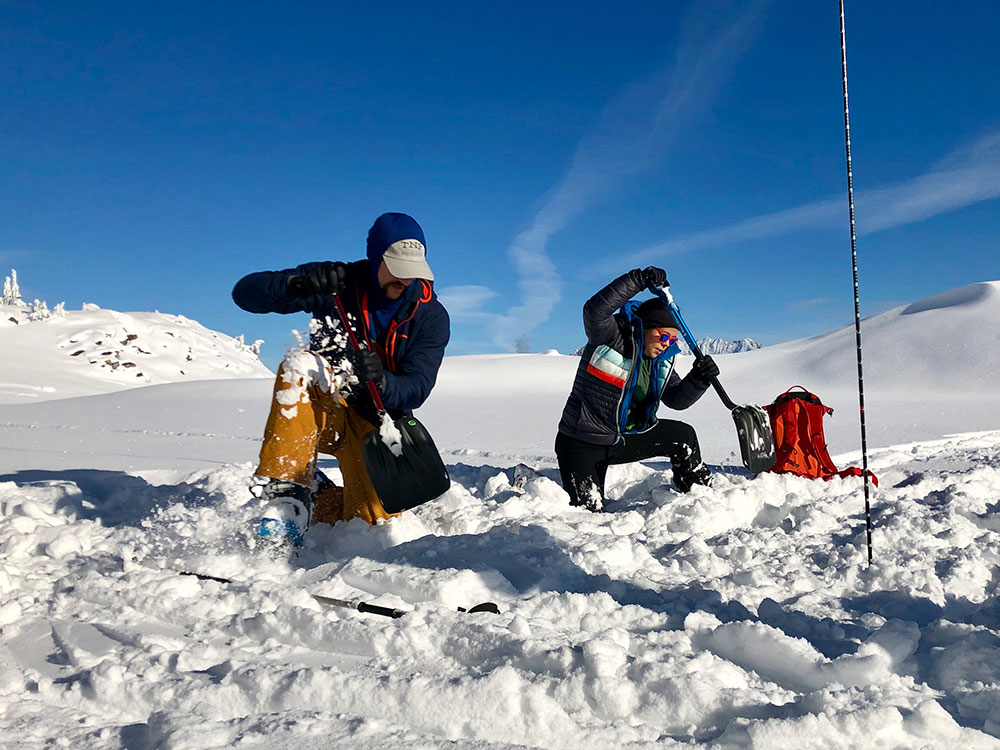
Strategic Shoveling Techniques
Be Proactive
I would be remiss to not remind you all that the best way to survive an avalanche is to be proactive and not get caught in one to begin with. Take an Avalanche Course and get the education to avoid needing your shovel for anything but training weight. Then, since this post is geared towards just the shoveling aspect of a rescue, make sure that you understand Single Burial Avalanche Rescue techniques and how to use your Avalanche Beacon and probe to pinpoint a buried person’s location.
Shoveling 101: The ABCs
Once you’ve pinpointed a buried individual with a probe strike, the ABC’s tell you where to start digging.
Airway: Start digging downhill of the probe strike (and avoid standing on or above the probe) to preserve the airway of the buried individual.
Burial Depth: The burial depth tells you how far downhill you need to be before digging in towards the probe. The general rule is 1.5x the burial depth found on your probe, but moving one step downhill for a 1 meter or less burial and 2 steps downhill for anything greater than 2 meters is easier to remember and just as effective.
Clearing Snow: Ideally, you’ll clear snow downhill and to the sides by either chopping or paddling (depending on conditions) in order to create a platform 1-2 meters wide nearest your victim and 2 meters wide at the back like in the diagram below. This allows you to have space to provide first aid after excavating the victim. To achieve this platform efficiently, start by clearing snow to the sides. This keeps the downhill side from building up with a lot of snow — preserving it for snow removal later once the hole is deeper. Once the hole is deep enough that lifting snow up and over the sides is inefficient and tiring, paddle snow downhill and to the sides.
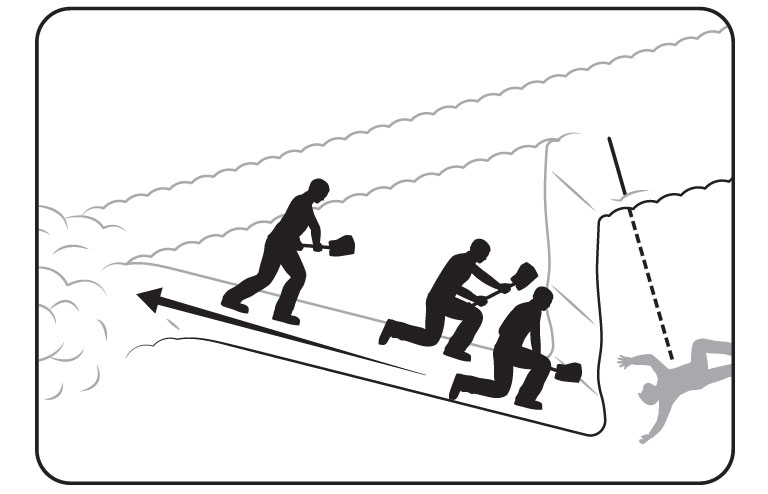
Single Rescuer
If you’re alone doing a rescue, that’s a huge bummer. This means you’re doing all the lifting (quite literally). Keep the ABCs in mind as you dig. Start downhill, and move snow downhill and to the sides as efficiently as possible. You’re still aiming to get the slightly angled platform above.
Conveyor Belt
With more rescuers, the more resources you have, but using those rescuers efficiently can be a challenge. A simple method to keep folks organized is the conveyor belt method. This works best with four or more rescuers. The video below demonstrates the method. Take note: partway through the video a fifth person shows up and violates the “A” of the ABCs by standing on top of the victim. Don’t do this.
Below is another video of the conveyor belt method. This time with 10 rescuers.
To Summarize…
Time is against you in an avalanche rescue, so efficiency is key. In order to get more efficient at strategic shoveling takes practice that can’t come from reading about it. So take an Avalanche Course. There you will learn how to best practice rescue on your own so you can build good habits. Hopefully you’ll never have to perform an actual avalanche rescue, but prepare for the worst. Below is one more video from BCA that does a pretty good job of reviewing most these concepts. Stay safe out there!
Want to learn more? Check out our Ultimate Guide to Backcountry Skiing.
Avalanche Course
Pro-Rec Split
Big changes are coming to avalanche education! After much anticipation, the long awaited professional – recreational split has arrived. The main outcome has been the creation of a professional track for advanced level avalanche courses. However, recreational backcountry skiers and snowboarders will find the new recreational curriculum to be more engaging and applicable as well. If you are considering taking an avalanche course, then read on!
Professional vs Recreational Goals
Often, recreational backcountry enthusiasts and aspiring avalanche professionals have very different goals that require different skill sets.
Aspiring avalanche professionals are commonly interested in the science of avalanche formation and release, snowpack metamorphism, and meteorology. It’s important that avalanche professionals have very well developed observational techniques and recording methodologies that reflect industry standards. These skills sets serve the professional well when forecasting, tracking, and managing avalanche hazard in the context of an operation.
Recreational skiers and snowboarders can also benefit from a deeper understanding of the avalanche phenomenon and observational techniques. However, these skills are applied very differently in a recreational setting. Often, recreational students are much more interested in tracking the spatial variability of the avalanche problems, and mitigating the hazard via terrain management and small group decision making. Basically, folks want to go backcountry skiing & riding, just more safely.
Avalanche Course Flow
The American Avalanche Association (AAA) is the organization in the United States that connects, engages with, and shares information amongst avalanche professionals from all segments of the industry and across all regions of the country. With input from industry and avalanche educators, the AAA created new standards that reflect the split in recreational and professional avalanche education. Organizations like the American Institute for Avalanche Research and Education (AIARE) use these standards to create curriculum and courses that can be distributed amongst a network of course providers and avalanche instructors.
The AAA has produced a useful flow chart that outlines the new framework for avalanche education in the United States. The goals of the new framework are to improve the quality of education for both professional and recreational students, maintain affordability for both user groups, and create common standards recognized by course providers, employers, and the public.
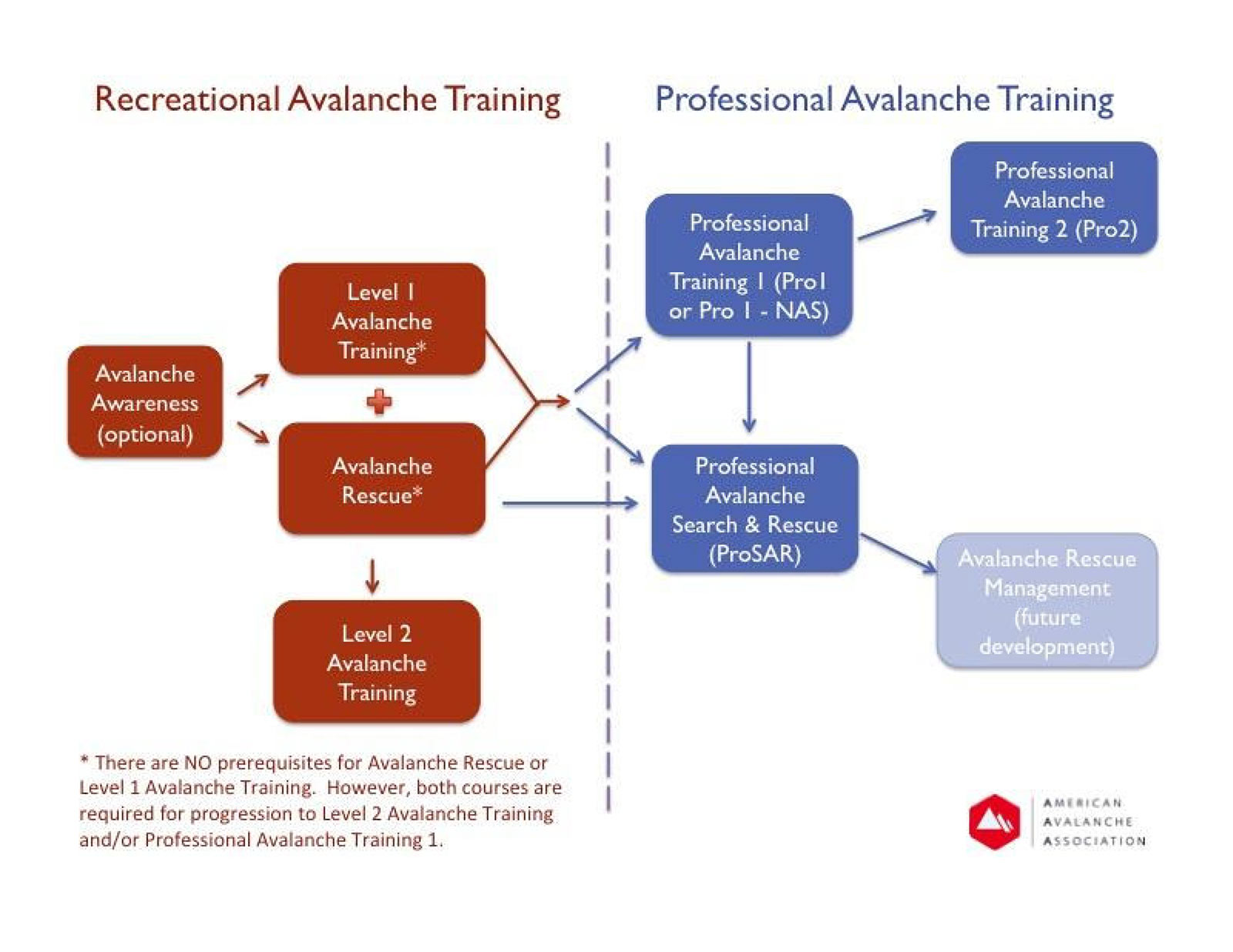
So where does one begin? As always, we encourage anyone who is interested in the backcountry to attend an avalanche awareness clinic. However, the AIARE Level 1 avalanche course is more appropriate for skiers and snowboarders who are planning on regular backcountry travel. The avalanche awareness clinic is not a pre-requisite for the AIARE Level 1.
The good news is that the AIARE Level 1 avalanche course remains unchanged. Everyone will still begin with the AIARE Level 1 regardless of whether they are recreational students or aspiring professionals. Students who choose to continue their avalanche education beyond the AIARE Level 1 will need to decide whether they are recreational backcountry travelers, or wanting to pursue a career as a ski or avalanche professional.
Recreational Avalanche Training
Recreational skiers and snowboarders who are interested in advanced avalanche education should consider the new AIARE Level 2 avalanche course. The AIARE Level 2 is now 3 days instead of 4. Avalanche Rescue has been removed from the curriculum and is now a stand-alone course. The AIARE Avalanche Rescue course is a pre-requisite for the new AIARE Level 2, so in effect, completion of the level 2 still requires 4 days of training.
The new AIARE Avalanche Rescue Course can be taken independently of the AIARE Level 2, however, Baker Mountain Guides and many other providers will offer the Avalanche Rescue Course immediately preceding the Level 2. At Baker Mountain Guides, we offer a discount on Avalanche Rescue if you take both courses together. The new AIARE Avalanche Rescue Course will allow for a full day of advanced companion rescue training and include many opportunities to practice multiple burial search techniques.
Additionally, the recreational level 2 curriculum focuses less on standardized observations and recording methods. This frees up more time for touring, informal observations, and group decision making. The goal is to improve student’s evaluation of critical avalanche hazard assessment factors.
The recreational curriculum ends with completion of the AIARE Level 2.
Professional Avalanche Training 1
Professional level courses will be run directly through AIARE and other AAA approved providers. Students will begin their professional avalanche education with the Professional Avalanche Training 1 course. The AIARE Level 1 and the AIARE Avalanche Rescue Courses are pre-requisites for the Pro 1.
The Pro 1 is designed for entry-level avalanche professional, or those seeking employment in the avalanche industry. The Pro 1 is similar to the old AIARE Level 2, but allows more time for students to develop their standardized observational skills, recording methods, and operational decision making. The Pro 1 is 5 days in length and includes an examination at the end of the course to ensure student competency.
Professional Avalanche Training 2
The Professional Avalanche Training 2 course replaces the old AIARE Level 3. Pre-requisites for the Pro 2 include the AIARE level 1, AIARE Avalanche Rescue course, and Pro 1.
From the AAA: Professional Avalanche Training 2 (Pro 2) is designed for developing avalanche professionals with several seasons of applied professional experience. This course focuses on skills and proficiencies that enable the student to step into a leadership role within an operational avalanche program. The student will be taught proficiencies to develop operational risk management decision-making skills, including forecasting, risk mitigation strategies, and professional communication.
For more information on professional level courses, please visit the AIARE Pro Course Schedule. Students must register for these courses directly through AIARE.
Baker Mountain Guides Avalanche Courses
Baker Mountain Guides offers our students the AIARE Level 1 Avalanche Course, AIARE Avalanche Rescue Course, and AIARE Level 2 Avalanche Course.
Baker Mountain Guides has customized the AIARE curriculum to provide practical field skills for the Pacific Northwest. Our instructors are passionate backcountry skiers and snowboarders who believe that avalanche education has the power to save lives. These values are reflected in the quality of our AIARE Avalanche Courses.
Thanks for taking the time to learn about changes to avalanche education in the US. Allow us to help you continue your education this winter with one of our comprehensive and respected courses. For more information about our offerings, please get in touch.